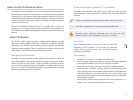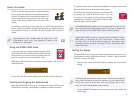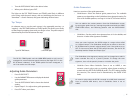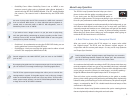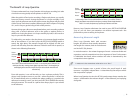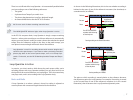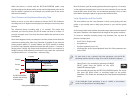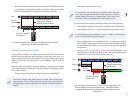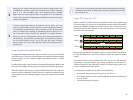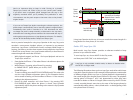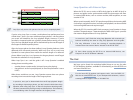
Here’s an important thing to keep in mind: Turning on a phrase’s
Tempo Sync switch will make it play at the current patch tempo.
If you don’t want its playback speed changed from the way it was
originally recorded—which you’ll probably find preferable in most
circumstances—set the patch tempo to the same value as the phrase’s
original tempo.
If you turn on Tempo Sync before recording the reference phrase, the
patch tempo is automatically set to match the phrase’s original tempo
immediately after audio is recorded in it. This eliminates the need
to change the patch’s tempo manually as discussed in the tip above,
and makes the recording process seamless. We recommend this way of
working when using a phrase as a Loop Quantize reference. For details,
see the RC-50 Workshop booklet Tempos and Tempo Sync.
Here’s a practical example for using Loop Quantize in this way: Say you’ve
recorded a two-measure rhythmic phrase—or imported a two-measure
drum loop—into Phrase 1, and Phrases 2 and 3 are empty. While Phrase 1 is
looping, you’d like to record a three-measure chord progression into Phrase
2. Here’s how to use Phrase 1 as a Loop Quantize reference, so that Phrase 2’s
measure length will match that of Phrase 1:
With playback stopped, set Phrase 1 for looped playback and turn its
Tempo Sync switch on.
Start playback of Phrase 1. This makes Phrase 1 the reference phrase for
Loop Quantize.
While Phrase 1 is looping, select Phrase 2 by pressing
its PHRASE SELECT pedal. When you do this, LOOP
QUANTIZE lights.
To start recording, press the REC/PLAY/OVERDUB pedal. This action also
sets the Loop Quantize adjustment point. (In the illustration below,
we’ve started recording on the downbeat of Phrase 1’s first measure,
making it the adjustment point.)
Record for three measures and close Phrase 2 by pressing REC/
PLAY/OVERDUB again. When the phrase is closed, Loop Quantize
automatically adjusts the phrase ending to the nearest Loop Quantize
adjustment point.
�
�
�
�
5�
Phrase 1
(Tempo
Sync on)
Two measures
Three measures
Phrase 2
Rec start
When REC/PLAY/OVERDUB
is pressed, Phrase 2’s ending is
adjusted to Phrase 1’s nearest
Loop Quantize point
CCC
CCC
CCC
CCC
CCC
CCC
CCC
CCC
CCC
CCC
CCC
CCC
CCC
CCC
CCC
CCC
CCC
CCC
CCC
CCC
CCC
CCC
CCC
CCC
Press REC/PLAY/OVERDUB
within this range
Using Loop Quantize in this way, it’s easy to match the measure length of a
long phrase to a short phrase, or vice versa.
Guide: OFF, Loop Sync: ON
Multi mode’s Loop Sync feature provides an alternate method to keep
phrases in sync with each other.
To turn Loop Sync on, choose MULTI for the Play mode,
and then press LOOP SYNC so its indicator lights.
Loop Sync is only available in Multi mode; its button is disabled when
the RC-50’s in Single mode.
The following illustration shows you how Loop Sync works after audio’s been
recorded in a patch’s phrases. In this example, all three phrases contain audio
of different lengths. With Loop Sync on, looped playback is determined by
the overall length of the longest phrase (Phrase 2 in this case). The playback
starting points of Phrases 1 and 3 are determined by when they were
recorded in relation to Phrase 2’s length. (When necessary, the RC-50 locks
a newly recorded phrase’s start time to the start of the longest phrase by
automatically adding silence—that is, blank audio—to the beginning of the
new phrase when it’s closed.)




